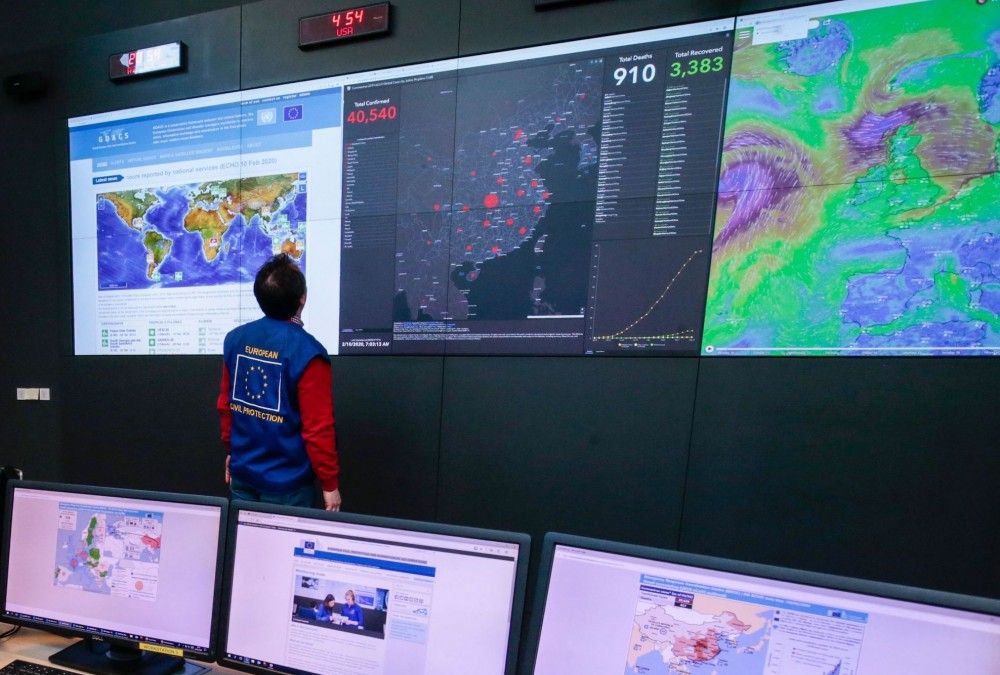
The CDC's 'Disease Detectives' Are Our Front-Line Defense Against Coronavirus
The men were frozen. Tattooed faces still beneath the fluorescent lights of the intensive care unit, eyelids taped shut. Only their stiff chests heaved, medical grade oxygen forced through tubes into their lungs. “So glad you’re here,” said the ICU attending, a doctor at least two decades my senior. “We’ve been waiting for the expert.”
The men were inmates at a maximum-security prison in the middle of the Arizona desert. They had been working out in their cells, yelling as they did push-ups and burpies, when the outbreak struck. One man slumped to the ground between push-ups, his tongue thick and heavy, speech slurred. Heeelllppp. Another tried to peer across the hallway but his eyelids were drooping, he was no longer in control of his face. Medical! Someone call medical! one guy shouted, noting two, then four, then six men stumbling in their cells, alone, face muscles paralyzed, chest muscles unable to move.
I was not an expert in paralyzed inmates. I had twenty years less experience as a doctor than the ICU attending. But I was a disease detective in the Epidemic Intelligence Service, and my tag line, delivered in my British accent, was “I’m from the U.S. federal government and I’m here to help.”
The Epidemic Intelligence Service is an elite squad of contagion-hunters who helicopter into outbreaks hoping to halt their spread. Borne out of America’s fear of biological warfare during the Korean War, the Intelligence Service has since responded to outbreaks of plague and Ebola, discovered new pathogens, and investigated threats of anthrax, and worse. Housed within the Centers for Disease Control and Prevention, these disease detectives are at the forefront of the new epidemic, deployed to disease hot spots around the world — including California.
Santa Clara County health officials on Friday announced they think they’ve found a second American infected with the new coronavirus through “community exposure” — a find that comes two days after the first American likely infected the same way was confirmed critically ill at another northern California hospital.
The women are two of the around 60 Americans diagnosed with the new disease, COVID-19, caused by the novel coronavirus SARS-CoV-2, which first emerged in humans in December 2019. (The first U.S. coronavirus U.S. death was confirmed Saturday in Washington state.)
But these two cases are exceptional: community exposure means they did not travel to epidemic areas or have contact with anyone known to be sick with the new disease. Their stories, of possible infection in the U.S., more than 6,000 miles away from the epicenter of the epidemic in Wuhan, China, pushes officials closer towards a pandemic declaration and leaves health investigators scrambling to understand where, when and how they became infected.
Uncovering the source of an outbreak, discovering patient zero, tracking down who coughed on who and where each exposed and infected person traveled, requires charm, patience and hustle. (The Epidemic Intelligence Service logo features the worn out sole of a boot laid over a globe.) High-tech medical advances such as rapid genome sequencing help in the fight against contagion, but play a surprisingly small part. As we saw with the SARS pandemic of 2002-2003, tried and tested nineteenth century techniques — such as face-to-face interviews and contact tracing — are critical in conquering the spread of even the most modern pandemics.
The old-school techniques help disease detectives build a social network of who was exposed while the infected person might have been shedding virus. Every contact, and every contact’s contact, is noted, interviewed and monitored for signs of illness. Especially when there is no treatment or cure for a new pathogen, this bare bones detective and surveillance work helps contain the epidemic. In the current situation, when it appears we are past the point of containment, contact tracing can help slow the spread of contagion.
It’s difficult and sometimes dangerous work. In the Arizona ICU, I searched for clues inside the men’s blood and guts. Plasma samples and stool were scrutinized but the real story wasn’t inside the ICU, it was inside the prison. The men couldn’t talk to me, they couldn’t even breathe alone, so I donned a stab vest, face shield and helmet and begged the prison warden to let me search the prison and interview the so-far healthy inmates. He thought I was joking. “These are the most dangerous men in the state,” he countered. I didn’t care. My job was to run towards places breeding disease and death, places other people were fleeing. I wasn’t scared of pathogens or serial killers. I was young and healthy and my life’s work was to stop epidemics. Reluctantly, the warden let me trawl the prison for evidence and agreed to let me and my team interview hundreds of men, each one cycling through a booth, awkwardly balancing a phone in his shackled hands.
I was gathering information about who had done what and gone where, and when, the most basic and most critical aspect of an epidemiological investigation. I learned that the men spent 23 hours alone in a cell each day with only one hour of outdoor recreational time in an outdoor cage. They ate alone — a plastic tray of food shoved under their cell door — and showered alone. Yet something, a virus, a toxin, I wasn’t sure what, had passed between them and could still be spreading through the prison.
Some of the inmates I was interviewing hadn’t talked to a woman in years. Some hadn’t received a visitor in almost a decade. And here I was, peppering them with questions about sex and food and work outs. One of the men apologized for his face tattoos — tear drops, dice and a Joker figure were plastered across his forehead and cheeks. Another, a self-described “brew master,” eventually confided that the men in the ICU had been drinking before they got sick.
I added “How do you brew alcohol in a prison?” to my already long list of questions, and out poured recipes for dozens of variations of prison hooch, pruno and toilet wine — so-called because scraps of leftover food, pizza crust, pineapple chunks, and ketchup, are sequestered in a plastic bag, warmed in the crotch or armpits and shoved inside the toilet when correctional officers flip the cells each day. The men had tied the bag full of fermenting food with a piece of string and flushed the bag when the officers searched the cell. They tugged on the string after the officers left, and cradled and “burped their baby” allowing gases to release.
But in brewing this batch of toilet wine, the men had inadvertently cooked up the world’s most lethal nerve toxin, Botulinum, a toxin so powerful that, by some estimates, half a teaspoon could knock out half of humanity.
“These Arizona boys didn’t make it properly,” the brew master scolded, leaning closer into the Plexiglas. “I’m from Cali and I would have made it different.”
The investigation didn’t end there. Even as I dispatched the national stockpile of botulinum antitoxin — a stash kept in case of biological warfare — and wiped out the entire west coast supply at a cost of hundreds of thousands of dollars, another mystery emerged. How did one batch of poisoned hooch get into so many cells. “Impossible,” said the warden. “Each man must have made the liquor in his own cell.” We both knew he was lying. I had to build trust with the correctional officers — a crew who was pissed off by my demands to ferry hundreds of inmates to and from their cells the visitation booths — to find out how contraband moves through a maximum-security prison. “It doesn’t,” said one guard, “nothing gets past us.” Eventually he confided that officers sometimes transport goods between inmates, “you know, just to keep the peace.”
It had been more ingenious than that. The outdoor cage was separated from another outdoor recreational area by eight-inch cinder blocks. The block had drainage holes. One of the men had purchased coaxial cable from commissary, (it was sold so they could watch TV), hollowed out the cable, attached it to the nozzle of the sports-style water bottles the prison issued, and squirted the toxin-tainted hooch through the cinder blocks to a man in an entirely different wing.
The men narrowly survived death and spent months learning how to walk and talk again, their nerves shot, their emotions labile. Solving the mystery of the prison outbreak required weeks of careful questioning, building trust with leaders, guards and the inmates, begging for access to seemingly inaccessible places, and asking hundreds of prisoners to share information they knew I couldn’t keep secret.
Solving the mystery of the two California cases will require that same kind of diligent, patient and painstaking questioning. Who did you speak to? Where did you eat? Did you go to work while you had symptoms? But memories can be vague and answers sometimes fudged. The anxiety of an epidemic and the stigma of infection can drive people to secrecy. So you pack away official uniforms, dress in jeans and tees, and try to build trust quickly, and provide reassurances constantly.
At least one of the California women who likely became infected locally has a breathing tube in her lungs. She can’t describe her life, where she went or who she spoke to. Investigators will piece together details by talking to her worried family members, friends and coworkers, hoping to solve the mystery of where and how she came into contact with the new virus. Anyone exposed to the two women will have to be isolated to minimize the ongoing transmission of the virus within the community.
The emergence of new viruses is to be expected. It won’t be a surprise if the disease detectives confirm local transmission of the new infection within California. With a virus that has spread to more than 50 countries, infected more than 80,000 and killed close to 3,000 people in less than two months, it’s arrival in my Bay area neighborhood was to be expected. More than 60 Americans are known to have COVID-19. A series of mistakes and delays with testing means many more Americans are likely carrying the virus but unaware, another non-surprise since early data shows some people suffer few symptoms or have a very mild version of the disease, allowing them to pass it on without realizing the risk.
The rush to find treatments, develop a vaccine and produce better tests will continue. But the boots on the ground investigators who are knocking on doors, deploying calm voices while peppering Californians with intrusive questions about relationships, hobbies and habits, are our first defense against further local spread of the new virus. Uncovering the clues to an epidemic, one that is inching ever closer to a pandemic, relies on their tact and tenacity.
Seema Yasmin is an Emmy Award-winning medical journalist, doctor, and author. She is director of the Stanford Health Communication Initiative and clinical assistant professor in the Stanford University Department of Medicine. Her Twitter handle is @DoctorYasmin.



